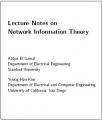A Short Course in Information Theory
by David J. C. MacKay
Publisher: University of Cambridge 1995
Description:
Is it possible to communicate reliably from one point to another if we only have a noisy communication channel? How can the information content of a random variable be measured? This course will discuss the remarkable theorems of Claude Shannon, starting from the source coding theorem, which motivates the entropy as the measure of information, and culminating in the noisy channel coding theorem. Along the way we will study simple examples of codes for data compression and error correction.
Download or read it online for free here:
Download link
(multiple PDF,PS files)
Similar books
 Quantum Information Theory
Quantum Information Theoryby Robert H. Schumann - arXiv
A short review of ideas in quantum information theory. Quantum mechanics is presented together with some useful tools for quantum mechanics of open systems. The treatment is pedagogical and suitable for beginning graduates in the field.
(16306 views)
 Lecture Notes on Network Information Theory
Lecture Notes on Network Information Theoryby Abbas El Gamal, Young-Han Kim - arXiv
Network information theory deals with the fundamental limits on information flow in networks and optimal coding and protocols. These notes provide a broad coverage of key results, techniques, and open problems in network information theory.
(14378 views)
 The Limits of Mathematics
The Limits of Mathematicsby Gregory J. Chaitin - Springer
The final version of a course on algorithmic information theory and the epistemology of mathematics. The book discusses the nature of mathematics in the light of information theory, and sustains the thesis that mathematics is quasi-empirical.
(12668 views)
 Entropy and Information Theory
Entropy and Information Theoryby Robert M. Gray - Springer
The book covers the theory of probabilistic information measures and application to coding theorems for information sources and noisy channels. This is an up-to-date treatment of traditional information theory emphasizing ergodic theory.
(16932 views)